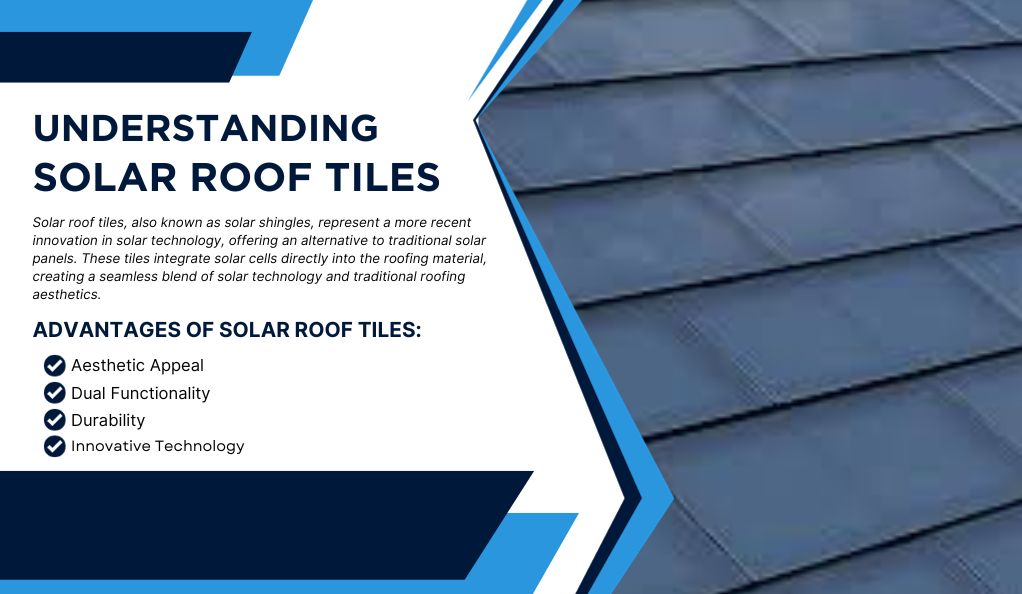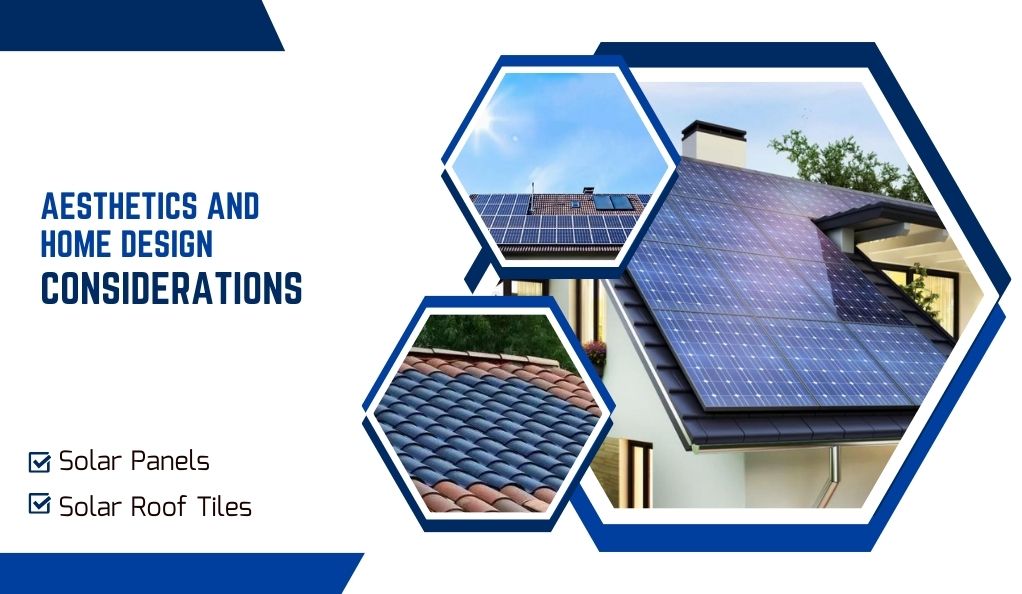Solar energy has emerged as a forefront solution in the quest for renewable energy, particularly for residential use. Homeowners now have the option to harness the sun’s power directly from their rooftops, but the choice between solar roof tiles and solar panels can be perplexing. This section delves into an overview of these two technologies, highlighting their significance in today’s energy landscape.
Solar Panels and Solar Roof tiles
Traditional solar panels are photovoltaic (PV) systems that are mounted on rooftops. They consist of a collection of solar cells made from silicon, which convert sunlight into electricity. These panels have been the go-to choice for residential solar energy for decades, offering an effective way to reduce electricity bills and carbon footprints. The efficiency of solar panels typically ranges from 16% to 22%.
Also known as solar shingles, solar roof tiles integrate photovoltaic technology into roof shingles. They emerged as an innovative solution that combines traditional roofing materials with solar PV cells. This technology is relatively newer, having been introduced in the market around 2005. Solar roof tiles have an efficiency range of approximately 10-20%, slightly lower than traditional solar panels.
Understanding the financial implications of installing solar technology is crucial. For those interested in solar roof tiles, a comprehensive guide titled Understanding the Cost of Solar Shingle Installation offers detailed insights into the investment required. This resource can be especially helpful in comparing costs and benefits between traditional solar panels and solar roof tiles, assisting homeowners in making informed decisions based on their specific needs.
The Importance of Choosing the Right Solar Solution
The decision to install solar panels or solar roof tiles involves several factors, including cost, energy needs, aesthetics, roof type, and long-term investment goals. While solar panels are often lauded for their efficiency and cost-effectiveness, solar roof tiles offer an aesthetically pleasing alternative that blends seamlessly with the architectural design of homes. However, they tend to be more expensive and less efficient compared to traditional panels.
Understanding Solar Roof Tiles

Solar roof tiles, also known as solar shingles, represent a more recent innovation in solar technology, offering an alternative to traditional solar panels. These tiles integrate solar cells directly into the roofing material, creating a seamless blend of solar technology and traditional roofing aesthetics.
Design and Integration: Solar roof tiles are designed to look like conventional roofing materials. They are made of photovoltaic cells that can be integrated into existing roofing tiles or used as the primary roofing material. This integration allows for a more aesthetic and less obtrusive solar energy solution, as the solar cells are not as visible as traditional panels.
Advantages of Solar Roof Tiles
- Aesthetic Appeal: The most significant advantage of solar roof tiles is their aesthetic appeal. They blend in with the roof, maintaining the home’s original design and curb appeal.
- Dual Functionality: Solar roof tiles serve as both a roofing material and an energy-generating system. This dual functionality can be especially cost-effective if the roof needs replacement.
- Durability: Many solar tile manufacturers claim high durability, with some offering warranties of up to 20 years. They are often designed to withstand harsh weather conditions.
- Innovative Technology: Solar roof tiles represent a cutting-edge combination of roofing and solar technology, making them an attractive option for those looking for the latest in home energy solutions.
Limitations of Solar Roof Tiles:
- Lower Efficiency: Solar roof tiles generally have a lower efficiency, ranging from 10-20%, compared to traditional solar panels.
- Higher Cost: The cost of solar roof tiles can be significantly higher than traditional solar panels. This is due in part to the newer technology and the complexity of integrating the tiles into the roof.
- Installation Requirements: Installing solar roof tiles often requires professional expertise, particularly if they are being integrated into existing roofing. This can limit their availability and increase installation costs.
- Roof Compatibility: Solar roof tiles are best suited for new constructions or roofs that are being replaced. They may not be as versatile as solar panels in terms of the types of roofs they can be installed on.
Efficiency Comparison: Tiles vs. Panels
When choosing between solar roof tiles and solar panels, one of the critical factors to consider is efficiency — how effectively these systems convert sunlight into usable electricity. This section provides a detailed comparison of the efficiency of solar roof tiles and solar panels.
Solar Panel Efficiency
Solar panel efficiency typically falls within the range of 16% to 22%. This efficiency is primarily attributed to advancements in photovoltaic technology and materials, including monocrystalline and polycrystalline silicon. In terms of space utilization, solar panels outperform solar tiles, generating more electricity per square foot, making them a more space-efficient choice for harnessing solar energy.
Solar Roof Tile Efficiency
Solar roof tiles typically exhibit an efficiency range of 10% to 20%. This lower efficiency compared to traditional solar panels can be attributed to the design and integration of solar tiles with roofing materials, which may partially obstruct their exposure to sunlight. However, it’s worth noting that advancements are ongoing, and over time, solar roof tile technology is expected to improve, potentially narrowing the efficiency gap between them and conventional solar panels.
Aesthetics and Home Design Considerations

When integrating solar energy solutions into a home, the aesthetic impact is a significant factor for many homeowners. This section compares how solar panels and solar roof tiles affect the visual appeal and design of a home.
Solar Panels
Traditional solar panels can have a noticeable and bulky visual impact, protruding from the roof’s surface and often clashing with the architectural style of homes. They offer limited aesthetic customization, mainly available in standard sizes and a few color options like blue or black. Additionally, their installation involves mounting systems that elevate them above the roof, potentially causing visual intrusion for homeowners concerned about the appearance of their roofs.
Solar Roof Tiles
Solar roof tiles excel in seamless integration with the roof, ensuring a discreet and harmonious solar solution. They are designed to mimic traditional roofing materials and come in a variety of styles and colors, allowing for greater versatility in matching the home’s architectural design. This aesthetic appeal enhances the overall curb appeal of the home, particularly appealing to homeowners who prioritize a traditional or seamless appearance for their roofs.
Considerations for Homeowners:
- Architectural Style: The choice between solar panels and tiles may depend on the architectural style of the home. Traditional and historic homes might benefit more from the less obtrusive look of solar tiles.
- Home Value Impact: While both options can increase home value, solar roof tiles might have an edge due to their aesthetic appeal and modern technology.
- Neighborhood and Regulations: Some neighborhoods or homeowners’ associations might have regulations or preferences regarding the visual impact of solar installations.
Durability and Lifespan
The longevity and durability of solar installations are crucial for assessing their value over time. This section compares the durability and lifespan of solar panels and solar roof tiles, considering factors like material robustness, weather resistance, and maintenance requirements.
Lifespan of Solar panels and tiles
Solar panels feature durable tempered glass construction, built to endure harsh environmental conditions. Their lifespan typically spans 20 to 25 years, with potential functionality beyond that at reduced efficiency. These panels are highly weather-resistant, capable of withstanding strong winds, hail, and heavy snow loads. Maintenance is minimal, mainly requiring occasional cleaning and damage checks. If any panel is damaged, individual replacement is usually possible without impacting the entire solar system.
Solar roof tiles use durable materials, often fortified with robust glass to endure environmental challenges. While relatively new, they are expected to match traditional solar panels’ lifespan, typically backed by 20-year warranties from manufacturers. Designed for weather and impact resilience, some models excel in areas prone to severe weather. Nevertheless, maintenance can be more complex, as damaged tiles may necessitate complete replacement.
Key Takeaways for Homeowners:
- Investment Longevity: Both solar panels and solar roof tiles are long-term investments. While solar panels have a proven track record, solar roof tiles are expected to offer comparable longevity.
- Suitability for Environment: The choice may depend on the local climate and weather conditions. Both options provide robust weather resistance, but the impact resistance of solar tiles may be a deciding factor in certain regions.
- Maintenance Considerations: Solar panels offer ease of maintenance, which is an important consideration for long-term upkeep. Solar roof tiles, while durable, may require more complex maintenance.
Environmental Impact and Energy Independence
The adoption of solar technology plays a pivotal role in reducing carbon footprints and promoting environmental sustainability. This section evaluates the environmental impact and potential for energy independence offered by solar panels and solar roof tiles.
Environmental Impact of Solar Panels
- Reduction of Carbon Footprint: Solar panels significantly reduce greenhouse gas emissions by replacing energy generated from fossil fuels.
- Energy Production: Due to their higher efficiency, solar panels can generate more electricity, thus contributing more substantially to reducing reliance on non-renewable energy sources.
- Recyclability: While solar panels are not completely recyclable, ongoing advancements are improving their environmental friendliness over their entire lifecycle.
Environmental Impact of Solar Roof Tiles
- Eco-Friendly Roofing Solution: Solar roof tiles provide an environmentally friendly roofing option by combining energy generation with traditional roofing materials.
- Reduced Emissions: Like solar panels, they contribute to lowering carbon emissions by generating renewable energy.
- Material Use: The integration of solar cells into roofing materials can result in more efficient use of resources, though the recyclability of these combined materials is still an area for development.
Energy Independence
Solar Panels: With their higher efficiency, solar panels can provide a significant amount of a home’s energy needs, potentially leading to complete energy independence, especially when paired with energy storage solutions.
Solar Roof Tiles: While less efficient, solar roof tiles can still contribute significantly to a home’s energy requirements. Their aesthetic appeal might encourage broader adoption, furthering the impact on overall energy independence goals.
Conclusion
Choosing between solar panels and solar roof tiles for your home hinges on balancing aesthetics, efficiency, cost, and environmental impact. Solar panels offer higher efficiency and a more established track record, making them a cost-effective choice for energy savings. In contrast, solar roof tiles provide an aesthetically pleasing alternative, ideal for new constructions or roof replacements despite their higher cost and lower efficiency. Ultimately, the decision should align with your personal preferences, energy needs, and long-term sustainability goals.
